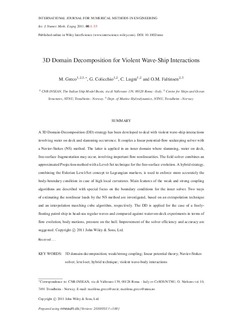3D Domain Decomposition for Violent Wave-Ship Interactions
Journal article
Submitted version
Permanent lenke
http://hdl.handle.net/11250/2469778Utgivelsesdato
2013Metadata
Vis full innførselSamlinger
- Institutt for marin teknikk [3432]
- Publikasjoner fra CRIStin - NTNU [38127]
Originalversjon
International Journal for Numerical Methods in Engineering. 2013, 95 (8), 661-684. 10.1002/nme.4523Sammendrag
A 3D Domain-Decomposition (DD) strategy has been developed to deal with violent wave-ship interactions involving water-on-deck and slamming occurrence. It couples a linear potential flow seakeeping solver with a Navier–Stokes method. The latter is applied in an inner domain where slamming, water-on-deck, and free surface fragmentation may occur, involving important flow nonlinearities. The field solver combines an approximated projection method with a level set technique for the free surface evolution. A hybrid strategy, combining the Eulerian level set concept to Lagrangian markers, is used to enforce more accurately the body boundary condition in case of high local curvatures. Main features of the weak and the strong coupling algorithms are described with special focus on the boundary conditions for the inner solver. Two ways of estimating the nonlinear loads by the Navier–Stokes method are investigated, on the basis of an extrapolation technique and an interpolation marching cubes algorithm, respectively. The DD is applied for the case of a freely floating patrol ship in head sea regular waves and compared against water-on-deck experiments in terms of flow evolution, body motions, and pressure on the hull. Improvement of the solver efficiency and accuracy is suggested.
